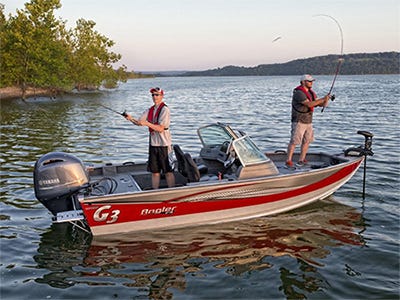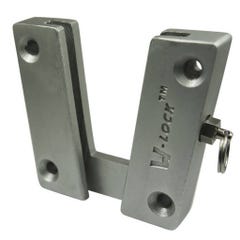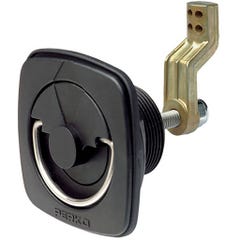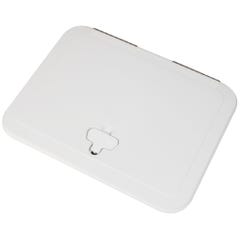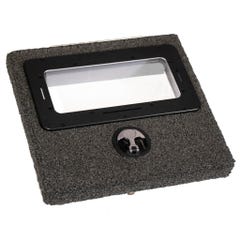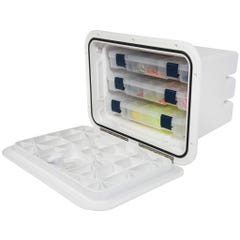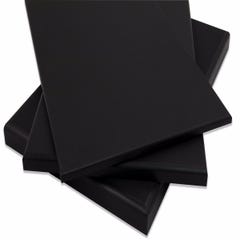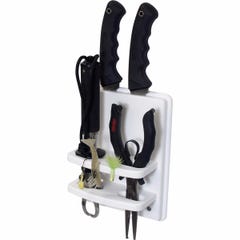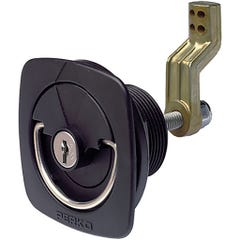Aluminum Boats: Pros & Cons
May 09, 2023 6 min read


It’s one of the first questions you’re likely to consider while shopping for a boat: Aluminum or fiberglass (by “fiberglass,” we’ll mean “and including other composite layups”)?
Contents
Choosing Between Aluminum & Fiberglass
Fiberglass has a couple of clear advantages. The complexity of hull shape and sleek gel-coated lines that can be achieved with fibers and resin have both aesthetic and performance implications. Strakes, chines, and spray rails just lend more subtle elegance to a hull when done in glass.
Fiberglass is also quieter on the water; waves hitting aluminum boats make more noise than waves hitting fiberglass, a consideration for shallow-water fishing boats. And fiberglass will beat any metal in the clean-up and corrosion resistance categories.
But aluminum has come a long way in aesthetics and performance. Aluminum hulls are now made with more precise shaping than in the past, better construction methods, and more creature comforts. Aluminum is no longer solely a choice for cheap utilitarian tubs and not much more.
Metal Fundamentals
Aluminum is a material that lends itself to a wide range of fabrication techniques and applications. It’s light, strong, corrosion resistant and easy to work with compared to other metals. It’s an excellent material for boat building.
Aluminum boats come in two varieties of construction: riveted and welded.
Welded Aluminum Hulls
Welded aluminum hulls are generally considered superior — stronger, more durable and maintenance free. Rivets are susceptible to loosening and corroding, so a riveted hull is going to require a slight bit more maintenance over time, with annual check overs and possibly rivet replacements down the line.
Welded boats will usually execute a more complex hull design.
Riveted Aluminum Hulls
Riveted aluminum hulls reside mainly in the lower end of the aluminum boat market. Welded hulls take a higher level of skilled labor to manufacture than riveting, and welded boats will usually execute a more complex hull design. These factors add up to a relative premium in the pricing of welded boats.
On the other hand, there are many riveted boats out there that have been in service for decades.
The thickness of the aluminum used in a build will of course also factor into hull strength and weight. Hull thickness ranges just six or seven hundreths of an inch for car-top jon boats to a quarter inch on heavy duty welded boats.
All aluminum alloys are not created equal either — properties vary. Some provide better corrosion resistance than others. You’ll find 5052, 5083, 5086 and 6061 aluminum alloys in boats, with 5086 the preference for bottoms and sides.
Boat Weight Wisdom
In boatbuilding, the lightest material doesn’t always win. Heft has its uses, particularly in service of stability. The U.S. Navy uses a lot of steel. And fiberglass boats, which are generally much heavier than aluminum boats of the same size and shape, tend to ride more softly and predictably in rough water.
In instances where weight savings are important, though, the lighter weight of aluminum can be a big plus. Aluminum means you get a bigger boat with the same displacement, or a lighter boat of the same size. A lighter boat translates to increased capacity for people and gear, reduced horsepower requirements, easier towing and launching, and improved fuel efficiency. Lighter boats are also easier to paddle or pole.
Wear and Tear
Metal boats take abuse better than fiberglass boats do, and in rough country the pretty glass boats get scarce. If you go up into the lakes of, say, the Canadian Shield, you just won’t find many fiberglass boats, which says something about something. This is a slice of hardcore tin boat country, lots of it still poorly charted, where rocky reefs frequently jut from the depths to within inches of the surface. Rocky shorelines call for metal boats.
Where boats have the potential to get a little beat up, aluminum is a clear winner. Aluminum can split, but an impact with a rock or dock is much more likely to result in a dent than a fracture. Fiberglass, on the other hand, is less malleable than aluminum and more prone to cracking or breaking when it’s hit hard.
Likewise, although aluminum can scratch, scrape and scuff, from brushes with rocks, logs, docks, oysters and so on, it’s the same color all the way through, so the resulting marks aren’t readily apparent. With fiberglass, on the other hand, scratches and scrapes often go through the gelcoat to the fiberglass underneath, leaving ugly marks and also allowing water to potentially penetrate between the gelcoat and the glass.
Cost Considerations
There are exceptions, but generally speaking, aluminum boats are less expensive than fiberglass boats, all else being equal. That’s especially apparent in the world of bass and other freshwater fishing boats, where aluminum and fiberglass boats compete head-to-head. (In most other segments, one material or another dominates.
Offshore center consoles, for example, are virtually all fiberglass, while Northwest-style river jetboats are virtually all aluminum.) But compare a similarly equipped 20’ aluminum bass boat and 20’ fiberglass bass boat, and the aluminum version will almost certainly cost less. Because it’s lighter weight, the aluminum boat will also require a smaller, less expensive outboard for equivalent performance and burn less gas on the water, extending the savings.
Customizations
There is no shortage of old tin boats, which are easy to work with and customize. If you are looking to do a custom conversion — build out a 1654 jon boat for deluxe bass fishing or duck hunting, for example — getting your hands on a hull to work with should not be too hard.
Aluminum hulls have numerous ready anchor points for framing, starting with ribs. Using synthetic materials like Starboard will contribute to a professional looking build with a long life.
Aluminum also lends itself to DIY customizations since it’s less finicky than fiberglass.
Aluminum also lends itself to DIY customizations since it’s less finicky than fiberglass. Anytime you penetrate fiberglass — especially if it’s cored fiberglass — you run the risk of water intrusion and, ultimately, delamination, waterlogging and so on. Aluminum, on the other hand, is impervious to water all the way through, so cutting, drilling and sealing is significantly simpler.
Corrosion and Care
There’s no way around it — aluminum corrodes in saltwater, while fiberglass doesn’t. That being said, tens of thousands of aluminum boats are operated regularly in saltwater all over the world without turning to dust. Just know that preventing (or minimizing) corrosion on an aluminum hull in saltwater requires some additional measures, such as sacrificial anodes on the hull.
On the other hand, aluminum, unlike fiberglass, requires virtually no maintenance. Gelcoated fiberglass degrades without at least regular waxing. In the real world, most fiberglass boats need to be cleaned, polished and waxed one or more times a year to keep the gelcoat from deteriorating. Aluminum looks prettier with cleaning and maintenance, but functionally speaking none is needed except a freshwater rinse after use in saltwater.
Preventing corrosion on an aluminum hull in saltwater requires some additional measures.
Like Everyone Else Does
You don’t have to follow the crowd, but the boat market in your area, both used and new, will tell you a lot about the local preferences and what suits the local scene.

